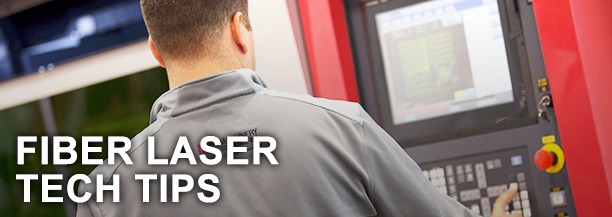Fiber lasers themselves are not new; they’ve been used in welding applications since the 1980s. The technology is relatively new for metal cutting, although Europeans began to use the technology long before its North American introduction. Ever since the discussion of choosing between fiber or CO2 lasers and/or making the switch from the more established CO2 has been a hot topic. Here, we’ll explore the similarities and differences and provide some tips for making the switch.
Fiber laser cutting has its advantages, but you have to have the right application for the technology—namely, if you cut thin sheet metal with thicknesses up to 4 mm (0.6 in.) then fiber laser cutting may be an option for you. It can offer energy savings of up to 30 percent in wall plug efficiency compared to CO2 type lasers.
Fiber lasers are high-powered solid-state lasers that offer a shorter wavelength (close to the visible spectrum light) compared to CO2 lasers (fiber laser wavelength is 1.07 µm and CO2 laser wavelength is 10.6 µm in the infrared part of the spectrum). A characteristic of a shorter wavelength is that it’s more readily absorbed into metals, which means higher cutting efficiency. The fiber lasers are generated in a fiber and created or stimulated by pumping light-emitting diodes through the fiber to produce the beam of light. Also, fiber lasers offer higher cutting accuracies. The beam of light gets delivered through the fiber, which is a constant length, so no matter how close or how far from the source that a fabricator is processing, the optical path length never changes. That means you don’t typically need adaptive optics found in CO2 lasers. Elimination of adaptive optics leads to another advantage with this technology: less maintenance as fabricators don’t have to fiddle with multi-mirror alignment.
SWITCHING FROM CO2 TO FIBER
The average operator, who has many years of experience with CO2 systems, may find the switch to fiber frustrating. This frustration does not come from increased difficulty, but increased simplicity.
With fiber lasers, the tweaking and adjustments we are used to basically go away altogether. This is due to the solid-state construction of the fiber oscillator and delivery system. These systems are not affected by temperature or thermal degradation, as is the case with CO2 systems.
In CO2 systems, temperature and optical life will, over time, reduce power and quality of cut. Operators adapt to this by changing feed-rate and focus settings. This is the biggest hurdle for an operator when moving to fiber, as their first instinct is to slow the speed down.
So, what should be done if you encounter cutting issues? It comes down to three simple checks:
- The Nozzle – Is the correct nozzle being used? Make sure it is undamaged, centered, and calibrated. The nozzle is a critical and central element in ensuring optimal cutting conditions.
- The Protective Window and/or Lens – Is there a spot on the window or lens? This can be checked by running a mode burn program. If any spots are seen, the optics should be replaced.
- The Cutting Condition – Is the condition the correct one for the material being processed? If you are cutting a material that does not match the database, for example, a new grade of steel, always create a new condition. Never overwrite a factory setting if it can be avoided; that way, the next time you run that material, the setting will still be correct.
The biggest maintenance issue a new fiber operator will face is optical cleanliness. It is of utmost importance that the optical components are clean and dust-free. Unlike a CO2 laser, the fiber laser has a very small beam size with a very high-power density. This means any contamination on the protective window or lens will create an instant loss of cut.
Following the proper cleaning procedure and preventing contamination should be the biggest priority for any operator. A CO2 lens is cleaned and reinstalled daily as normal maintenance; for fiber though, the window is only cleaned when it is new, and then just replaced if any cutting problems occur. The less the optics are removed from a fiber cutting head, the less chance for contamination.
However, our eX-F laser all but does away with the risk of contamination and maintenance experienced with common fiber lasers. Its all-in-one, enclosed head safely seals the heads and eliminates cartridge changing—and often contamination—thanks to its 3.75-10 auto-focus range.
All in all, the idea is to keep things simple and always check the basics first. Contact MC Machinery to learn more about making the switch.

